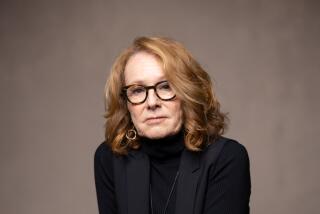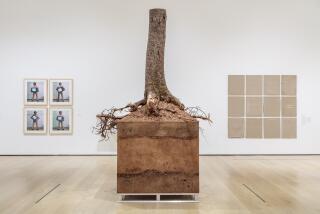Hammer’s ‘Made in L.A.’ biennial paints cross-generational picture
One day about 15 years ago, Channa Horwitz was at work in her studio atop a knoll in Hidden Hills. Something transpired on her drafting table that got her excited, and she wanted to share it and get feedback. In her 60s at the time, she had been working in semi-obscurity for decades.
“I was totally alone,” she recalls. “I was isolated. The mail lady came up the drive, and I said, ‘Can I show you what I just did?’”
The incident is emblematic of a career spent largely in solitary pursuit of answers to self-generated “what if?” questions. Since the ‘60s, Horwitz has been devising systems to visualize time. Her intricately patterned drawings in ink and paint on graph paper have been shown in several local galleries in the past six or seven years and are featured in “Made in L.A. 2012,” a biennial of new art organized by the Hammer Museum with the nonprofit Culver City space, LAXART. The show is on view at both venues as well as the L.A. Municipal Art Gallery in Barnsdall Park.
The curatorial team — Anne Ellegood and Ali Subotnick from the Hammer; and Lauri Firstenberg, Malik Gaines and Cesar Garcia from LAXART — selected 60 artists working in video, sculpture, installation, drawing, photography and performance. They focused on artists they identified as emerging or under-recognized, and in Horwitz, who turned 80 in May, they seem to have gotten both.
They describe her in the exhibition catalog as perhaps the oldest emerging artist in Los Angeles. But what is actually emerging is overdue attention to her work. The audience is the late bloomer here.
There are two other artists of similar vintage in the show: Simone Forti (born in 1935) and Morgan Fisher (1942). A few more are in their 40s, 50s and 60s, but most are in their 20s and 30s, an age the art world, like the culture at large, associates with freshness and novelty. The youngest is Kenyatta A.C. Hinkle, who was born in 1987 and received her MFA from CalArts this year. Los Angeles-born Horwitz earned her BFA there in 1972, after also studying at Cal State Northridge in the early ‘60s and Art Center School of Design in the early ‘50s, all while raising a family.
The dramatic age range wasn’t deliberate, the curators agree. It wouldn’t even be evident, Subotnick suggests, if birth dates were not disclosed. But, Ellegood points out, it reflects something significant about Los Angeles, something that pertains to how artists are trained and work here.
“More than in other cities, there’s a strong dialogue between generations. I attribute it a lot to the schools. Well-known artists continue to teach at a point in their careers where they don’t really need to for the money. That starts a dialogue with younger artists and those relationships maintain after school. The older artists take that role seriously. They value that exchange with younger artists. This happens to some extent in other cities, but it’s very consistent here and is part of the fabric of what makes the city tick.”
Fisher, who Firstenberg hails as “the godfather of conceptualism in L.A.,” has taught at UCLA, USC and Cal Arts intermittently since the ‘90s, and at least five of his students are in the Hammer/LAXART show. These cross-generational relationships are important to him.
“It’s a particular form of community that is very sustaining, even if my work is very different and I go my own way, as I guess we all do,” he wrote by email.
Forti teaches at UCLA in the department of world arts and cultures and is considered a pioneer within the dance and performance communities for her improvisations and her work integrating movement and speech. “We wanted to include her also as an object-maker,” Ellegood says. “Among many of the younger artists in the show, Simone is a role model, consciously or unconsciously, for the way she’s dealt with the negotiation of the body among objects.”
Horwitz has never taught. The show will put her work, at least, in dialogue with that of younger artists. She shares a gallery with Analia Saban, who, at just over 30, already has just as long a list of exhibitions to her credit.
Coming so close on the heels of the Getty’s Pacific Standard Time, “Made in L.A.” can easily be taken as a follow-up, a “that was then, this is now” update to the historical overview. If PST aimed, in part, to flesh out the record of art’s evolution in postwar L.A., the current show aspires to introduce and reintroduce names of artists working in our midst right now that ought to be more familiar. The older ones are not, for a variety of reasons.
All three enjoyed earlier or more substantive reception outside of L.A., primarily in Europe. The syndrome of prophets not being honored in their own land is all too common among Southern California artists, several of the curators concurred. Horwitz has had a handful of shows recently in Germany, and Fisher’s primary representation is in Cologne.
Contemporary culture’s emphasis on youth and novelty is probably the biggest culprit, however. Electronic gadgets aren’t the only things discarded and replaced after a short spell. Opportunities for artists get slimmer once they’ve aged out of the “emerging” category.
“A certain pressure, over time, has skewed the conversation,” Ellegood says, “so that institutions and platforms for showing art have become so intent on new talent that it has allowed for a certain amnesia about other ways of working and other important artists.”
Exhibiting institutions tend to showcase the fresh and new or pay tribute to the senior and well established, but artists in midcareer can fall into a “black hole,” says Ellegood, from which it’s hard to resurface.
The challenge of staying visible is compounded when an artist shifts gears, as Fisher did, starting anew as a painter in the late 1990s, after decades of making films.
“I am in the early phase of my career as a painter, the equivalent of being in my middle to late 30s if I had started as a painter,” he wrote, “so in principle I have decades ahead of me, and that is exactly how I feel.” Conventional ideas about career trajectories are confining, and not very productive, Fisher later said in conversation. Being categorized according to medium or age is equally detrimental.
“It’s conventional to think of young equating with new, but they don’t necessarily go hand in hand. In fact they rarely do. It has to do with this disconnect,” a misapplied association of youth with freshness and innovation. “Well, guess what? You can do work that’s new when you’re not a kid, when you’re not just getting out of graduate school.”
For Horwitz too, the notion that a career would naturally grow stale with age is anathema, ridiculous. She works now out of a studio in the middle of her home in West L.A., persisting out of “the love of doing, of creating my own world,” and the work never seems to exhaust itself. “If concepts run dry, I go through folders of working drawings. These folders are food for whatever I could possibly do in the future. I could have five lifetimes and not run out.”
Horwitz lasted decades without external recognition because, she says, she was “never really trying for it.” How does she feel about the flurry of attention she’s getting now?
“It has nothing to do with the work,” she said in a tone of exasperated good humor. “It makes it harder to work. It slows down the progress. It’s a pain in the neck and takes me away from my drafting table. And don’t think I don’t love it.”
More to Read
The biggest entertainment stories
Get our big stories about Hollywood, film, television, music, arts, culture and more right in your inbox as soon as they publish.
You may occasionally receive promotional content from the Los Angeles Times.










